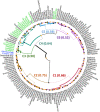Drug repurposing in Raynaud's phenomenon through adverse event signature matching in the World Health Organization pharmacovigilance database
- PMID: 32337731
- PMCID: PMC7576623
- DOI: 10.1111/bcp.14322
Drug repurposing in Raynaud's phenomenon through adverse event signature matching in the World Health Organization pharmacovigilance database
Abstract
Aims: Several pharmacological treatments are recommended for Raynaud's phenomenon (RP) secondary to systemic sclerosis, but they only have modest efficacy. A way to efficiently identify new drugs is drug repurposing, which can be based on signature matching. The signature could be derived from chemical structures, pharmacological affinity or adverse event profiles. We propose to use the World Health Organization (WHO) pharmacovigilance database to generate repositioning hypotheses for treatments of RP through adverse event signature matching.
Methods: We first screened all drugs associated with at least 1 case of erythromelalgia, an adverse effect opposite to RP. In parallel, to define the adverse event signature of drugs recommended in secondary RP from the WHO pharmacovigilance database, we selected the 14 most representative adverse drug reactions (ADRs). Lastly, we performed a hierarchical cluster analysis to identify drugs with similar ADR signature to vasodilatory drugs used in RP.
Results: In total, 179 drugs were associated with erythromelalgia; they were related to 860 334 adverse events representative of RP drugs in the WHO pharmacovigilance database. Hierarchical cluster analysis allowed identification of 6 clusters. The most stable cluster contained 7 drugs, among which 5 are recommended in secondary RP, or pertain to the same drug class: epoprostenol, nifedipine, nicardipine, lacidipine and israpidine. The 2 remaining drugs were alemtuzumab and fumaric acid.
Conclusion: Our ADR signature matching approach suggests that alemtuzumab and fumaric acid could be effective treatments of secondary RP. The latter is currently being investigated as a treatment of pulmonary hypertension in systemic sclerosis.
Keywords: Raynaud's phenomenon; drug repurposing; systemic sclerosis.
© 2020 The British Pharmacological Society.
Conflict of interest statement
M.R. reports grants from Bioprojet, grants from Pfizer France, grants from GIRCI Rhône‐Alpes‐Auvergne, grants from Association des Sclérodermiques de France, outside the submitted work. J.L.C. reports grants from BIOPROJET, grants from Pfizer France, grants from GIRCI Rhône‐Alpes‐Auvergne, grants from Association des Sclérodermiques de France, outside the submitted work. Z.P. and C.K. have nothing to disclose.
Figures
References
-
- Wigley FM, Flavahan NA. Raynaud's phenomenon. N Engl J Med. 2016;375(6):556‐565. - PubMed
-
- Khouri C, Lepelley M, Bailly S, et al. Comparative efficacy and safety of treatments for secondary Raynaud's phenomenon: a systematic review and network meta‐analysis of randomised trials. Lancet Rheumatol. 2019;1(4):e237‐e246. - PubMed
-
- Khanna D, Denton CP, Merkel PA, et al. Effect of Macitentan on the development of new ischemic digital ulcers in patients with systemic sclerosis: DUAL‐1 and DUAL‐2 randomized clinical trials. JAMA. 2016;315(18):1975‐1988. - PubMed
-
- Pushpakom S, Iorio F, Eyers PA, et al. Drug repurposing: progress, challenges and recommendations. Nat Rev Drug Discov. 2019;18(1):41‐58. - PubMed
Publication types
MeSH terms
Substances
LinkOut - more resources
Full Text Sources
Medical
Research Materials


